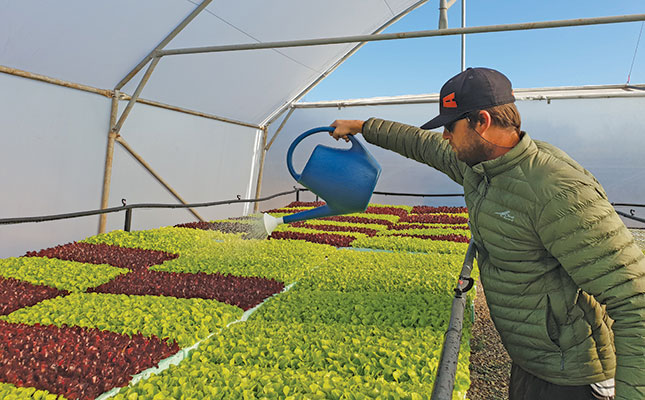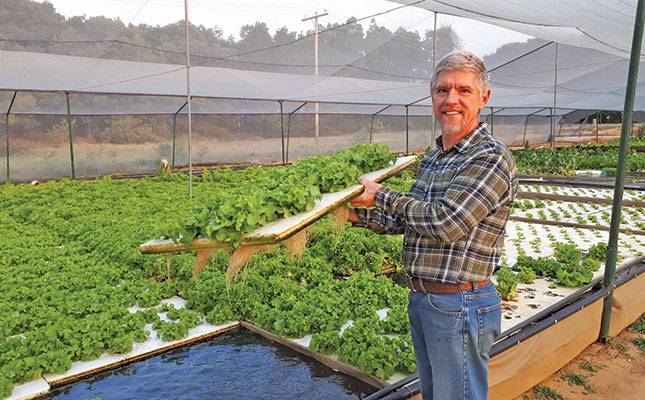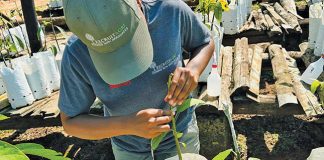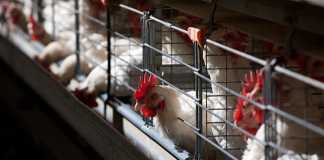
Photo: Supplied
Hydroponics ensures consistent quality and quantity
After receiving his bachelor’s degree in environmental sciences, Chris Rolfe knew he wanted to start a venture that he could be proud of. During his time at university, he also took horticulture and agriculture classes, which sparked a keen interest in food production. He realised that this was where his future lay, and chose to focus on environmentally friendly farming methods.
READ How aquaponics benefits children and the community
He began his journey by growing mushrooms, but soon realised that this crop alone was not profitable. He then conducted a great deal of research into aquaponics and hydroponics. Realising that his production knowledge was insufficient, he also researched the general fruit and vegetable market.
In 2019, Rolfe and his business partner, Phia le Roux, launched their hydroponics farm, Go Gourmet, in Pretoria East. Today, they produce both summer and winter crops, namely tomatoes, spinach, spring onion, lettuce, and various herbs.
Starting with 0,8ha, they now have 2ha under netting, with an additional 0,5ha under construction. They grow between 10t and 15t of produce each week during summer.
The business is run entirely on solar power, and rain is harvested for the hydroponics system.
“Solar power gives us a great advantage because, apart from the environmental benefit, we aren’t really affected by load-shedding,” explains Rolfe.
Go Gourmet uses an electronic fertigation system that maintains the correct water pH level and fertiliser mixes for the various crops. Water is constantly recycled and filtered, and new fertiliser added during the cycle.
According to Rolfe, the hydroponics system enables their crops to grow faster and also ensures higher-quality produce than that grown in a conventional system.
Challenges and the future
Go Gourmet started by supplying produce to the Tshwane Market, and now has a number of buyers.
“It hasn’t all been plain sailing,” admits Rolfe. “We had to find the right suppliers to set up the infrastructure, as well as a market and clients to sell to on a consistent basis.”
A couple of crucial aspects are required for success, he advises.
“You need to be hands-on to ensure that your farm is running at its full capacity and potential. The input costs for a hydroponics system are high, so efficiency is the key to receiving a return on your investment.”
READ Aquaponics: get it right, or grow veggies on their own!
He suggests that newcomers focus on spreading risk. “We quickly realised that in order to survive, we had to spread our risk between various buyers.”
He adds that supplying consistent quality produce is not negotiable. “If you constantly supply a product of superior quality, word will spread. Your clients will continue to support you. We’ve also found that our best way of advertising in the fresh produce industry is by word of mouth.
“Our mission is to grow healthy, nutritious and good-quality produce hydroponically, and we always try to improve in order to live up to this mission.”
Rolfe says they aim to continue expanding and improving their current infrastructure and systems.
“We have a 7ha property that we could potentially put under nets and greenhouses. We’re also considering introducing additional crops, and continue to build partnerships along the way.”
Email [email protected].
Aquaponics: a purely organic fish-and-crops system
Aquaponics is a food-production system that combines aquaculture (breeding, raising and harvesting fish) and hydroponics. And while it is one of a number of economically successful agriculture systems employed around the world, commercial aquaponics is still in its infancy in South Africa.

According to Annemarie Bremner, who co-owns Kleinskuur Aquaponics near Pretoria with her husband Colin, aquaponics is a highly sustainable farming method as it uses a self-contained ecosystem that mirrors nature.
“Aquaponics differs from hydroponics in that it doesn’t need the addition of chemical nutrients for the plants, as waste from the fish provides the plants with nutrients,” she explains.
She points out that there is also no build-up of waste that causes the water to become toxic. “In aquaponics, the bacteria in the waste converts ammonia into nitrates and nitrites, which the plants utilise as their main source of nutrients.”
According to the Bremners, aquaponics systems generally use 90% less water than other systems to grow the same volume of produce. They also don’t waste water, as it is recirculated.
In addition, aquaponics systems can be built on non-arable land. “You can buy cheaper land for aquaponics systems, and they can be erected close to cities, highways and the market, saving a lot on transport costs,” she says.
READ Choose the right hydroponics system for your operation
Fish are a crucial part of the equation. They essentially feed the plants, and the solid fibres that remain after the filtering and mineralisation processes can be used to make compost for wicking beds. This means zero nutrient loss.
The fish are sold once they reach market weight, providing an additional source of income that covers most of the running costs. “We use Nile tilapia [Oreochromis niloticus], as they’re easy to handle, grow fast, and allow for a much higher stocking density than trout, for example.”
The Bremners began their aquaponics journey after Colin was diagnosed with Barrett’s oesophagus (precancerous condition). “We were looking for the most natural way of producing food [to aid his recovery],” recalls Annemarie.
Grower and manufacturer
Kleinskuur not only grows fresh produce, but also supplies aquaponics systems. After attending courses in Stellenbosch held by internationally renowned experts, and studying the principles of aquaponics extensively, Colin designed a uniquely South African model that follows his motto of keeping it simple.
With their KSBA4000 Commercial System, they can produce 4t of tilapia and more than 16t of tomatoes a month, and 50 400 leafy green plants, such as lettuce, a month. The system takes up an area of less than 0,5ha.
“We call it the KSBA4000, because it contains 4 000 of our patented gravel barrels for fruiting (vine) crops,” says Colin.
Kleinskuur currently produces 10 000 heads of lettuce a month for packhouses, and grows a variety of other crops, including Swiss chard, kale, cherry tomatoes, strawberries, microgreens and herbs, which are sold to nearby hotels and conference venues.
“We’re also focusing on developing new product lines, such as duckweed,” adds Annemarie.
The new superfood?
Annemarie and Colin introduced duckweed, a free-floating aquatic plant that belongs to the subfamily Lemnoideae, into their aquaponics system as supplementary feed for the fish.
As the plant spread throughout the system, they started carrying out research on its benefits.
“We already knew that it’s high in protein, which is why we introduced it into our system as a food source for the tilapia. What we didn’t know was that duckweed might also be a source of vitamin B12. Tests are currently being done to confirm the presence of this vitamin in the plant,” says Annemarie.
Apart from its high nutrient content, duckweed has environmental and economic benefits. Annemarie says that it covers all the open spaces in their aquaponics system and thereby prevents evaporation, which, in turn, saves money. It also protects the environment.
“It helps to purify the water by using all the excess nutrients not absorbed by our other plants. This means that the water going back to our fish is clean and filtered.
“Poultry and sheep farmers can also use duckweed as supplementary feed in a wet or dry form,” she explains.
In terms of human consumption, duckweed shows great potential to be the next new superfood. According to Annemarie, duckweed contains between 32% and 35% protein, 20% starch, 5% oil and 20% fibre in its wet form. It can also be used in its original state or dried into a powder without losing any of its nutritional properties.
“Duckweed has been used in Asian cuisine for many years, but it’s only now being considered as a possible superfood in Western countries. Since we don’t use any harmful ingredients in our aquaponics system, we know that our ‘beyond organic’ duckweed is a great supplement for humans,” she says.
People have also been known to use duckweed for the treatment of inflammation in the airways, rheumatoid arthritis, and gout.
An improved aquaponics system
In Kleinskuur’s KSBA4000 system, the plants act as a filter for the water, which returns to the fish. The water is continually circulated throughout the system. The plants are cultivated in two ways:
In a deep-water culture system, where plants such as lettuce, Swiss chard, spinach and most herbs (basil, parsley, rocket and sage, for example) are grown; and in the gravel barrel system, where crops such as tomatoes, cucumbers, peppers, chillies, brinjals, baby marrows, patty pans and other herbs (mint and rosemary, for example) can be produced.
Aquaponics does not use harmful pesticides, chemicals or growth hormones, as these would harm both the fish and the plants. According to the Bremners, it produces the healthiest, most nutrient-rich food that can be grown in a controlled environment.
Colin says that theirs has proven to be an affordable and efficient system.
“The Kleinskuur Aquaponics system is designed to work with nature, not against it. We save on expensive equipment such as grow lights and ladders for harvesting.
“Our system makes effective use of 84% of the area in the tunnel for growing (the highest in the industry); walkways comprise the remaining 16%. The ergonomic and efficient design of the system makes for more efficient use of labour, too.”
Kleinskuur systems are not only used in South Africa, but are also being built in various other locations in Africa, including Namibia, Zimbabwe, Lesotho and Mauritius. “These systems can be established anywhere in Africa. We also provide aftersales assistance and training, and will go out to producers’ premises to give them support.”
Colin says the latest development at Kleinskuur is the design of a home-based aquaponics system for gardeners or small-scale farmers.
Email Annemarie Bremner at [email protected]. Visit ksba.co.za.













